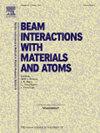铋薄膜中0.6-4.4 MeV H+和He2+快离子的停止功率和能量损失漂移数据:Heq+离子荷态效应的影响
IF 1.4
3区 物理与天体物理
Q3 INSTRUMENTS & INSTRUMENTATION
Nuclear Instruments & Methods in Physics Research Section B-beam Interactions With Materials and Atoms
Pub Date : 2025-06-02
DOI:10.1016/j.nimb.2025.165757
引用次数: 0
摘要
在0.6 ~ 4.4 MeV的宽能量范围内,研究了铋(Bi)薄膜中H+和He2+离子的停止功率和能量损失散乱。测量是在一个反向散射几何中进行的,该测量是在硅衬底上进行的,衬底上有一层非常薄的铜界面层,通过电子束蒸发沉积。首先将得到的停止结果与已有的两种离子靶体系(H+-Bi、He+-Bi)的数据进行比较,并与SRIM-2013、PASS-2.0和CasP-6.0三种不同计算机代码生成的数值进行比较。同时,将能量损失的离散值与上述两种离子靶系统的现有数据进行了比较,并与波尔和贝特-利文斯顿经典理论得出的碰撞离散值进行了比较。然后将整个离散数据与Yang等人最近为考虑新的实验数据而改进的半经验公式生成的数值进行比较。然后讨论了Heq+离子电荷态和相关电荷交换效应对测量的停止和离散数据的影响,最后与Efken等人的解析电荷交换公式进行了比较,该公式仅限于两个离子电荷态q(+ 1和+ 2)。本文章由计算机程序翻译,如有差异,请以英文原文为准。
Stopping power and energy loss straggling data of 0.6–4.4 MeV H+ and He2+ swift ions in bismuth thin films: Influence of Heq+ ion charge-state effects
The stopping power and energy-loss straggling of H+ and He2+ swift ions in bismuth (Bi) thin film were investigated for a wide energy range from 0.6 to 4.4 MeV. The measurements were performed in a backscattering geometry for ∼ 120 nm Bi-films on silicon substrate with a very thin interface layer of copper deposited by electron-beam evaporation. The obtained stopping results were first compared to previous data available for the two ion-target systems (H+-Bi, He+-Bi), and again to numerical values generated by three different computer codes of SRIM-2013, PASS-2.0 and CasP-6.0. While those of energy-loss straggling were compared to some previous data available for the above two ion-target systems and to collisional straggling values derived by Bohr’s and Bethe-Livingston’s classical theories. The whole straggling data were then compared to numerical values generated by Yang et al.’s semi-empirical formula recently refined to account new experimental data. The influence of Heq+-ion charge-state and related charge-exchange effects on the measured stopping and straggling data was then discussed, and finally completed by comparison with the analytical charge-exchange formula of Efken et al. limited to just two ion charge-states q of + 1 and + 2.
求助全文
通过发布文献求助,成功后即可免费获取论文全文。
去求助
来源期刊
CiteScore
2.80
自引率
7.70%
发文量
231
审稿时长
1.9 months
期刊介绍:
Section B of Nuclear Instruments and Methods in Physics Research covers all aspects of the interaction of energetic beams with atoms, molecules and aggregate forms of matter. This includes ion beam analysis and ion beam modification of materials as well as basic data of importance for these studies. Topics of general interest include: atomic collisions in solids, particle channelling, all aspects of collision cascades, the modification of materials by energetic beams, ion implantation, irradiation - induced changes in materials, the physics and chemistry of beam interactions and the analysis of materials by all forms of energetic radiation. Modification by ion, laser and electron beams for the study of electronic materials, metals, ceramics, insulators, polymers and other important and new materials systems are included. Related studies, such as the application of ion beam analysis to biological, archaeological and geological samples as well as applications to solve problems in planetary science are also welcome. Energetic beams of interest include atomic and molecular ions, neutrons, positrons and muons, plasmas directed at surfaces, electron and photon beams, including laser treated surfaces and studies of solids by photon radiation from rotating anodes, synchrotrons, etc. In addition, the interaction between various forms of radiation and radiation-induced deposition processes are relevant.

 求助内容:
求助内容: 应助结果提醒方式:
应助结果提醒方式:


